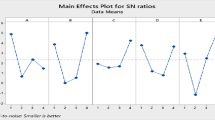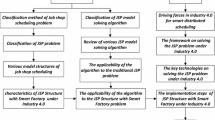Abstract
This paper presents a hierarchical approach to scheduling flexible manufacturing systems (FMSs) that pursues multiple performance objectives and considers the process flexibility of incorporating alternative process plans and resources for the required operations. The scheduling problem is solved at two levels: the shop level and the manufacturing system level. The shop level controller employs a combined priority index developed in this research to rank shop production orders in meeting multiple scheduling objectives. To overcome dimensional complexity and keep a low level of work-in-process inventory, the shop controller first selects up to three production orders with the highest ranking as candidates and generates all possible release sequences for them, with or without multitasking. These sequences are conveyed to the manufacturing system controller, who then performs detailed scheduling of the machines in the FMS using a fixed priority heuristic for routing parts of multiple types while considering alternative process plans and resources for the operations. The FMS controller provides feedback to the shop controller with a set of suggested detailed schedules and projected order completion times. On receiving these results, the shop controller further evaluates each candidate schedule using a multiple-objective function and selects the best schedule for execution. This allows multiple performance objectives of an FMS to be achieved by the integrated hierarchical scheduling approach.
Similar content being viewed by others
References
Anderson, E.J. and Nyirenda, J.C., “Two New Rules to Minimize Tardiness in a Job Shop,” International Journal of Production Research, Vol. 28, No. 12, pp. 2277–2292 (1990).
Ahluwalia, R.S. and Ji, P., “A Distributed Approach to Job Scheduling in a Flexible Manufacturing System,” Computers and Industrial Engineering, Vol. 20, No. 1, pp. 95–103 (1991).
Bedworth, D.D., Henderson, M.R., and Wolfe, P.M., Computer-Integrated Design and Manufacturing, McGraw-Hill, New York (1991).
Blain, J., Denning, M., Dodd, B., Elkington, G., Hewson, W., Hill, K., Lingard, J., Matthews, E., Tate, J.R., and Wor, P., Special Edition Using SAP R/3, Que Corporation, Indianapolis, IN (1996).
Boulet, B., Chabbra, B., Harhalakis, G., Minis, I., and Proth, J.M., “Cell Controllers: Analysis and Comparison of Three Major Projects,” Computers in Industry, Vol. 16, pp. 239–254 (1991).
Chan, D.-Y. and Bedworth, D.D., “Design of a Scheduling System for Flexible Manufacturing Cells,” International Journal of Production Research, Vol. 29, No. 11, pp. 2037–2049 (1990).
Changchien, S.-W., Lin, L., and Sun, D., “A Dynamic Control Model of Flexible Manufacturing Cells Using the Information Processing Object Hierarchy,” International Journal of Flexible Automation and Integrated Manufacturing, Vol. 3, Nos. 3–4, pp. 193–223 (1995).
Gershwin, S.B., “Hierarchical Flow Control: A Framework for Scheduling and Planning Discrete Events in Manufacturing Systems,” Proceedings of the Institute for Electrical and Electronic Engineers, Vol. 77, No. 1, pp. 195–299 (1989).
Grabot, B. and Geneste, L., “Dispatching Rules in Scheduling: a Fuzzy Approach,” International Journal of Production Research, Vol. 32, No. 4, pp. 903–915 (1994).
Ishii, N. and Talavage, J.J., “A Mixed Dispatching Rule Approach in FMS Scheduling,” International Journal of Flexible Manufacturing Systems, Vol. 6, No.1, pp.---87 (1994).
Jones, A. and McLean, C., “A Proposed Hierarchical Control Model for Automated Manufacturing Systems,” Journal of Manufacturing Systems, Vol. 5, No. 1, pp. 15–25 (1986).
Karsiti, M.N., Cruz, Jr., J.B., and Mulligan, Jr., J.H., “Simulation Studies of Multilevel Dynamic Job Shop Scheduling Using Heuristic Dispatching Rules,” Journal of Manufacturing Systems, Vol. 11, No. 5, pp. 346–358 (1992).
Kim, Y.-D., “A Comparison of Dispatching Rules for Job Shops with Multiple Identical Jobs and Alternative Routing,” International Journal of Production Research, Vol. 28, No. 5, pp. 953–962 (1990).
Larin, D.J., “Cell Control: What We Have, What We'll Need,” Manufacturing Engineering, pp. 41–54 (January 1989).
Law, A.M. and Kelton, W.D., Simulation Modeling and Analysis, 2d ed, McGraw-Hill, New York (1991).
Lin, L. and Fang, Y.-J., “Database Model for Hierarchical Control of Manufacturing Cell Systems in a Manufacturing Shop,” Computer Integrated Manufacturing Systems, Vol. 6, No. 3, pp. 185–194 (1993).
Lin, L., Wakabayashi, M., and Adiga, S., “Object-Oriented Modeling and Implementation of Control Software for a Robotic Flexible Manufacturing Cell,” Robotics and Computer-Integrated Manufacturing, Vol. 11, No. 1, pp. 1–12 (1994).
Liu, S.-C. and Lin, L., “Dynamic Sequencing of Robot Moves in a Manufacturing Cell,” European Journal of Operational Research, Vol. 69, No. 3, pp. 482–497 (1993).
MacCarthy, B.L. and Liu, J., “A New Classification Scheme for Flexible Manufacturing Systems,” International Journal of Production Research, Vol. 31, No. 2, pp. 299–309 (1993).
Montazeri, M. and Van Wassenhove, L.N., “Analysis of Scheduling Rules for an FMS,” International Journal of Production Research, Vol. 28, No. 4, pp. 785–802 (1990).
Moreno, A.A. and Ding, F.-Y., “A Constructive Heuristic Algorithm for Concurrently Selecting and Sequencing Jobs in an FMS Environment,” International Journal of Production Research, Vol. 31, No. 5, pp. 1157–1169 (1993).
Miyazaki, S., “Combined Scheduling System for Reducing Job Tardiness in a Job Shop,” International Journal of Production Research, Vol. 19, No. 2, pp. 21–211 (1981).
Nahmias, S., Production and Operations Analysis, Richard D. Irwin, Homewood, IL (1993).
Nasr, N. and Elsayed, E.A., “Job Shop Scheduling with Alternative Machines,” International Journal of Production Research, Vol. 28, No. 9, pp. 1595–1609 (1990).
Ranky, P., The Design and Operation of FMS (Flexible Manufacturing Systems), IFS Ltd., Kempston, UK (1983).
Rochette, R. and Sadowski, R.P., “A Statistical Comparison of the Performance of Simple Dispatching Rules for a Particular Set of Job Shops,” International Journal of Production Research, Vol. 14, No. 1, pp. 63–75 (1976).
Shanker, K. and Tzen, Y.-J., “A Loading and Dispatching Problem in a Random Flexible Manufacturing System,” International Journal of Production Research, Vol. 23, No. 3, pp. 579–595 (1985).
Shmilovici, A. and Maimon, O.Z., “Heuristics for Dynamic Selection and Routing of Parts in an FMS,” Journal of Manufacturing Systems, Vol. 11, No. 4, pp. 285–296 (1992).
Simpson, J.A., Hocken, R.J., and Albus, J.S., “The Automated Manufacturing Research Facility of the National Bureau of Standards,” Journal of Manufacturing Systems, Vol. 1, No. 1, pp. 17–31 (1982).
Vepsalainen, A.P.J. and Morton, T.E., “Priority Rules for Job Shops withWeighted Tardiness Costs,” Management Science, Vol. 33, No. 8, pp. 1035–1047 (1987).
Watanabe, T., Tokumaru, H., and Nakajima, Y., “Job-Shop Scheduling Using Fuzzy Inference to Make Profit into Account,” Proceedings of the 1992 Japan/USA Symposium on Flexible Automation, ASME, Vol. 1, pp. 423–427 (1992).
Wein, L.M., “Scheduling Networks of Queues: Heavy Traffic Analysis of a Two-Station Network with Controllable Inputs,” Operations Research, Vol. 38, No. 6, pp. 1065–1078 (1990).
Wein, L.M. and Chevalier, P.B., “A Broader View of the Job-Shop Scheduling Problem,” Management Science, Vol. 38, No. 7, pp. 1018–1033 (1992).
Wilhelm, W.E. and Shin, H.-M., “Effectiveness of Alternate Operations in a Flexible Manufacturing System,” International Journal of Production Research, Vol. 23, No. 1, pp. 65–79 (1985).
Williams, D.D., Manufacturing Systems, Open University Press, Milton, UK (1988).
Author information
Authors and Affiliations
Rights and permissions
About this article
Cite this article
Tung, LF., Lin, L. & Nagi, R. Multiple-Objective Scheduling for the Hierarchical Control of Flexible Manufacturing Systems. International Journal of Flexible Manufacturing Systems 11, 379–409 (1999). https://doi.org/10.1023/A:1008183330452
Issue Date:
DOI: https://doi.org/10.1023/A:1008183330452




